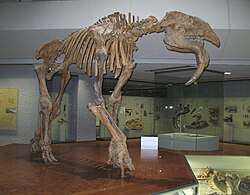Prodeinotherium
| Prodeinotherium | ||
|---|---|---|
| Rango temporal: Mioceno | ||
 Prodeinotherium bavaricum | ||
| Taxonomía | ||
| Reino: | Animalia | |
| Filo: | Chordata | |
| Clase: | Mammalia | |
| Orden: | Proboscidea | |
| Suborden: | †Deinotheroidea | |
| Familia: | †Deinotheriidae | |
| Subfamilia: | †Deinotheriinae | |
| Género: | †Prodeinotherium Ehik, 1930 | |
| Especies | ||
| Sinonimia | ||
| ||
[editar datos en Wikidata] | ||
Prodeinotherium (pro - "antes" y Deinotherium "bestia terrible") es un género extinto de proboscídeo perteneciente a la familia Deinotheriidae, que vivió en África, Europa y Asia a principios y mediados del Mioceno.[1]
Descripción

Prodeinotherium alcanzaba el tamaño del actual elefante asiático, con cerca de 3 metros hasta los hombros, pero difería de los elefantes por poseer un par de colmillos vueltos hacia abajo en su mandíbula inferior.
En apariencia general y mucha características era similar a Deinotherium (con el cual forma la subfamilia Deinotheriinae (Sanders et al. 2004), pero difería en ser de menor tamaño, tener miembros delanteros más cortos, y además en varios detalles de la forma de los dientes.[2]
La especie más antigua de este género es Prodeinotherium hobleyi, que vivió en el Mioceno Inferior de Kenia, Namibia y Sudáfrica[1] (hace entre 18 a 20 millones de años). Los fósiles de Prodeinotherium hobleyi también fueron hallados en Jebel Zelten en Libia.[3] Un molar de un pequeño Prodeinotherium de Eritrea puede pertenecer también a esta especie y ser de la misma época.
Prodeinotherium hobleyi fue mayor y más especializado que su predecesor del Oligoceno, Chilgatherium. Floreció por varios millones de años, antes de ser súbitamente reemplazado a mediados del Mioceno por el gigantesco Deinotherium.[2]
Referencias
- ↑ a b c Paleobiology Database
- ↑ a b Sanders, W. J., Kappelman, J. & Rasmussen, D. T., 2004 New large-bodied mammals from the late Oligocene site of Chilga, Ethiopia. Acta Palaeontologica Polonica Vol. 49, no.3, pp. 365–392
- ↑ Natural History Museum of Crete
- John M. Harris (1978) Deinotherioidea and Barytherioidea. 315-332, in Maglio, V. J. & Cooke, H. B. S., (eds.) 1978: Evolution of African mammals, Harvard University Press, Cambridge & London
- Sanders, W.J., 2003, chap 10, Proboscidea, in Mikael Fortelius (ed) Geology and paleontology of the Miocene Sinap Formation, Turkey, Columbia University Press, New York
- Recreación de Prodeinotherium.
 Datos: Q2048802
Datos: Q2048802 Multimedia: Prodeinotherium / Q2048802
Multimedia: Prodeinotherium / Q2048802 Especies: Prodeinotherium
Especies: Prodeinotherium










